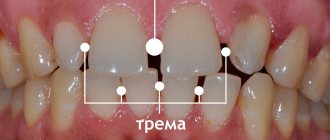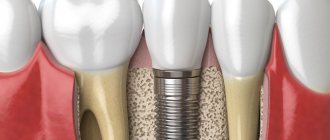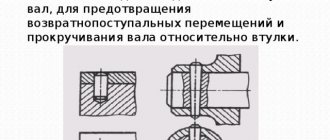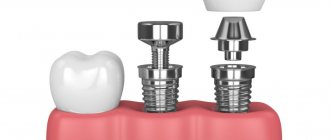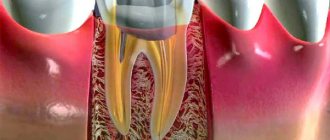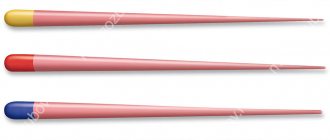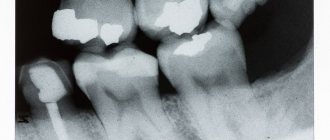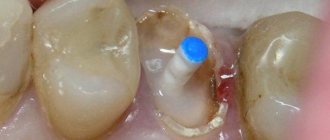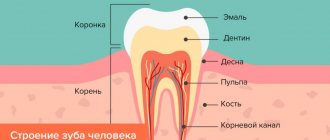Why install the pin?
The pin is installed in the tooth cavity for the purpose of:
- improving the fixation of the filling (in such cases, preference is given to fiberglass or ceramic products, since they do not shine through the composite restoration, thereby not disturbing aesthetic indicators);
- formation of a tooth stump from a filling material, followed by the manufacture of a crown for this tooth (in this clinical situation, installation of metal products is possible).
Pins are recommended for use in cases of significant destruction of the tooth crown due to caries, trauma, or increased abrasion of hard tooth tissues. They can also be used by dentists for restorations of the frontal group of teeth in case of their significant inclination.
Stump inlays
They are a classic example of the fact that everything new is well forgotten old. They were used back in the days when the Soviet dentist could not even think about anchor pins. True, the technology for their production left much to be desired. As a result, after the fall of the Iron Curtain, the appearance of anchor pins created a real sensation among dentists and inlays were forgotten for a while.
But a few years later, when they encountered the first complications, many doctors almost completely abandoned the pins and returned to inlays. By that time, high-precision casting technology “came” to us from Germany, ashless plastics and ashless pins appeared, which, unlike previously used wax, do not deform and allow the production of a stump insert of any length and shape.
Pin installation process
Since such structures are installed at the root of a tooth, the root canal must be hermetically sealed over its entire length, and not have any curvatures, too thin walls, or perforations.
How to insert a pin into a tooth:
- Passing the canal two-thirds of its length using a special tool - a root reamer with expansion of its cavity to the selected pin diameter. The length of the root part of the pin must be at least twice as long as the planned tooth stump.
- Antiseptic treatment of the canal (rinsing with antiseptic solutions, most often chlorhexidine), drying.
- Immersion of the pin into the formed canal and fixation with glass ionomer cement or dual-curing cement.
- Removing excess material.
- Modeling of a filling or tooth stump depending on the drawn up treatment plan.
Prices
| The doctor's consultation | |
| Titanium | From 1,250 ₽ |
| Fiberglass | From 3,000 ₽ |
Expert of the article you are reading: Svetlana Viktorovna Derevyakina Chief physician, doctor of the highest qualification category, therapist, periodontist, leading specialist of the NovaDent network
28 years
Clinical experience
Petrovsko-Razumovskaya
Verkhniye Likhobory
st. Dubninskaya, 27, building 1
+7
Free consultation with this specialist
Why does pain appear after installing a pin and what to do?
Even though the tooth is pulpless, pain may appear in it after the pin is installed. Most often, the cause of pain can be poor quality treatment of the tooth canals, and, as a result, the development of an inflammatory process. This may be incomplete removal of the tooth pulp, perforation of the root wall, or removal of the filling material beyond the apex. In such situations, you can try to treat the tooth, but the installed structure will have to be removed.
The tooth may also begin to hurt if the root wall is perforated by the pin itself when it is inserted.
A separate group of people have toothache after installing a pin due to an allergic reaction of the body to the construction material. This often happens when fixing polymer fiberglass products. Individual intolerance may also be to fixing cement.
Poorly manufactured crowns or fillings may also result in complaints of pain in the treated tooth. They are explained by the fact that the new orthopedic design increases the bite, and this tooth will bear the main load, which will respond with pain impulses in the periodontal nerves.
If the tooth hurts after installation, the pin must be removed to inspect the root canals, their possible re-treatment and decide on the issue of re-installation of the structure.
General overview
This type of teeth strengthening gets its name from the German word (anker). Indeed, the anchor pin, like an anchor, firmly fixes the crown or bridge structure in a stable position.
The pin is a metal rod that is installed in the root canal of the tooth, creating a framework for the intended work.
The design of the rod is heterogeneous: head, shoulder and tail. This creates bulk, but allows for increased strength and support of the prosthesis.
Important! A necessary condition for using this type of fixation is the good condition of the root canal.
Restoring a tooth by introducing a solid rod into the dental canal has been known for centuries. Over time, the method was improved - each generation used new materials, but the general principle remained the same.
Such longevity indicates the reliability of a time-tested method of returning lost teeth.
If the pin falls out
There are situations when the pin, together with the crown or filling made for it, falls out of the tooth cavity. In most cases, this situation is a consequence of medical errors at the stage of diagnosis or treatment. Reasons for unfixing may be:
- Incorrect determination of indications for pin installation;
- Poor quality fixation;
- Incorrect ratio of the length of the pin and the crown of the tooth;
- Incorrectly adjusted occlusal contacts.
Unfortunately, it is under no circumstances possible to fix the fallen structure back. In such cases, the tooth requires re-treatment, possibly using other methods of restoring the coronal part.
Restoring a tooth using a pin is an inexpensive and relatively quick option for prosthetics of a damaged tooth crown. It allows you to completely restore the lost function of the tooth, as well as achieve high aesthetic values. Since this is not only medical, but also aesthetic dentistry.
Kinds
Anchor pins differ in the type of fixation in the canal and in shape. There are also differences in the composition of the alloys used in their manufacture.
The choice of one type or another depends on the condition of the damaged tooth and the individual characteristics of the patient’s body.
After a thorough examination, the dentist recommends the most suitable option. In this case, it is necessary to comprehensively take into account the following aspects.
Material
In most cases, the choice of pin material is determined by the patient’s body’s response to it. It is very important to know the biocompatibility with the metal from which the anchor is made.
The materials used in their manufacture are alloys:
- of stainless steel;
- titanium;
- gold and platinum;
- palladium and silver;
- brass
In recent years, metal-free technologies for creating pins have become widely used. The various pin designs made from ceramics (IPSEmpress 2 system) successfully compete with traditional methods.
Innovative materials allow you to recreate the desired tooth configuration as accurately as possible. A big plus is also the absence of a metallic taste in the mouth.
Installation Methods
To determine the correct choice of anchor fixation method, you need to assess the degree of damage to the area being restored.
Two types of pins are used, regarding the method of their installation:
- Active. The pin rod is threaded and screwed into the bone tissue of the canal; Subsequently, additional fixation with cement is carried out.
This type of anchor is effective in case of complete tooth destruction and makes it possible to perform high-quality prosthetics.The use of active anchor pins requires special care in the procedure, since the canal walls may be destroyed during operation.
- Passive. Used to increase the strength of the restored tooth.
Passive anchors are not threaded, so they are secured in the oral cavity only with special cement. Recommended as a gentle option if more radical intervention is not required.
Sometimes, for certain indications, a combination of passive and active components is used. The thread is applied only to the upper part of the pin, the lower part remains smooth.
Advantages of using nanocomposites in dentistry and their characteristics.
Come here to evaluate the advantages of a ceramic tooth inlay.
At this address https://www.vash-dentist.ru/protezirovanie/nesemnyie-p/stiranie-zubov.html we’ll talk about methods of getting rid of increased tooth abrasion.
Pin shape
In addition to the method of securing the pin, its geometric shape plays an important role. It is selected based on the image data and examination of the visible part of the tooth damage. The following forms of anchor pins are commonly used:
- Cylindrical .
Due to the optimal fit with the shape of the root canal, it is the most preferred option. Most cylindrical anchors are threaded or serrated. Due to this fact, they are widely used in the active fixation method. Smooth cylindrical anchors are also used, but with passive fixation. - Conical. Conical anchors come in smooth and threaded types. Used (respectively) for passive and active fixation.
- Cylindrical-conical . They are used in case of minor damage to the visible part of the tooth, allowing it to be strengthened and for aesthetic restoration.
Important! In addition, Komet, DentsplyUnimetric) often produce a line of non-standard shapes and sizes.
If necessary, it is recommended to check with your dentist about the advisability of using such pins.
Reviews
People's opinions regarding the use of anchor pins are striking in their diversity. Among the negative ones, there are reviews from people whose tooth with an anchor has been functioning normally for 10 years, sometimes more.
But professional specialists are skeptical about this type of structure, considering them outdated.
For readers who have had experience using anchor pins, we invite you to share it and write your reviews in the comments to this article.
If you find an error, please select a piece of text and press Ctrl+Enter.
Tags anchor pins tooth extension pins
Did you like the article? stay tuned
Previous article
Modern methods of dental restoration in aesthetic dentistry
Next article
Learn in detail about all the nuances of dental treatment under a microscope
Advantages and disadvantages
Dentists highlight the following advantages of the anchor pin:
- Ability to restore the most severe types of damage (subject to the integrity of the root canal).
- High structural strength.
- Possibility of further prosthetics or filling.
- Low cost.
At the same time, the anchor design has a number of disadvantages: a high degree of corrosion (associated with the main material of the rod), an unaesthetic appearance (very often the structure is noticeable), the development of an allergy to the metal alloy that is included in the composition, the complexity of installation, which requires high professionalism of the dentist, such a pin is difficult can be removed or replaced - if such a need arises, it is removed along with the root of the tooth.
It is very important to consult with your doctor before installation and carefully study all the advantages and disadvantages of the procedure.
